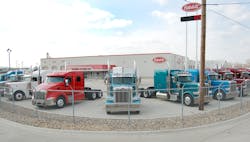Myth-Busting: Cost of ownership
During a FleetOwner Webinar presented yesterday, executives of professional -services firm Ernst & Young (E&Y) exploded myths they contend limit how fleet owners perceive--- and thus act on-- the total cost of ownership (TCO) of their trucking operations.
Because E&Y found it difficult to find comparable TCO benchmarks across fleets that differed by number of vehicles as well as vehicle age, the firm conducted its own TCO study on a cost-per-mile (CPM) basis ”to help fleets identify cost-savings opportunities,” said Donna Stella, a principal in E&Y’s Metropark, NJ-based Strategic Direction practice.
“Our analysis was segmented by number of vehicles in the fleet [1-24; 25-99; 100-499; 500+]and accounted for vehicle age,” Stella explained. “We also looked at several different industries [using trucks] and four key vehicle types: Class 8 tractors; Class 6 & 7 trucks; reefer trailers; and dry-van trailers.
Stella related that at least five significant insights came out of the study results:
1) Companies with larger-sized fleets typically incur a lower CPM.
2) Small- to medium-sized fleets can potentially save 5% to 36% by outsourcing the ownership and maintenance of their vehicles to larger firms that operate at a lower CPM.
3) Since maintenance costs increase exponentially as vehicles age, trucks and trailers should be replaced before they age too much so that accelerating maintenance costs and acquisition costs can be kept in balance.
4) Fleets buying vehicles with cash often do not include the cost of capital while making the purchasing decision.
5) Fleets often do not have the information necessary to fully evaluate their financial decisions
“We also found that CPM declines as fleet size increases,” reported Suchet Singh, senior manager of E&Y’s Strategic Direction practice. “And TCO decreased as fleet size increased for all [vehicle] unit types within the scope of the study.”
Noting that the study included a “deep dive” into maintenance costs, Singh said that for vehicles, “Year One and Year Seven see the highest average increase in maintenance costs and Year Six the smallest.” He interpreted that as indicating that “managing fleet age is critical to managing costs because maintenance CPM increases more rapidly as vehicles age.”
“The study also showed that many fleets have misperceptions about the cost of capital and the need to balance maintenance costs [against capital costs],” advised James Immordino,manager with E&Y’s Strategic Direction practice.
“Many [survey respondents] misperceived some of the potential cost advantages of leasing equipment vs. owning it,” Immordino continued. He said a key “misconception” revolves around vehicle purchase cost vs. maintenance expenses.
“Many think private ownership [of vehicles] provides better financial cost leverage despite [them] having a relatively small fleet size,” he elaborated. “But only very large fleets can gain the economies of scale [of owning large numbers of vehicles] that provide cost benefits.”
What’s more, Immordino said that to properly gauge a fleet’s TCO, all costs must be factored in, including these that have a very high impact:
· Vehicle purchase price
· Capital/financing
· Vehicle disposal
· “Self-maintenance”
· Contract maintenance
· Dealer/outside garage maintenance
· Parts and supplies
· Tires
· Maintenance overhead
Referring to one cost decision in particular, Immordino noted that the study found that “fleets are not getting the price savings [on maintenance and repair] from [OEM] dealers they thought they were getting.”
With that discovery in mind, Singh pointed out that “fleets should leverage their [vehicle] size to reduce costs and carefully evaluate the business case” regarding how and where maintenance is to be performed.
“Fleets can save through scale,” he stressed, adding that if they “do not have sufficient scale, they can reduce costs by outsourcing” vehicle ownership or maintenance. “It’s important to properly balance maintenance and [vehicle] financing costs and to evaluate whether to lease or own equipment.”
Singh concluded with a question for the live audience of over 500 persons: “How would you use the capital freed up from your fleet [by opting to lease equipment instead of buying it]?”
